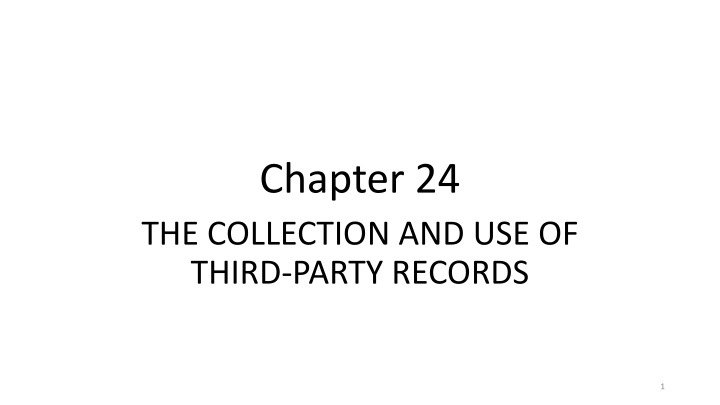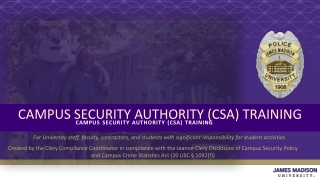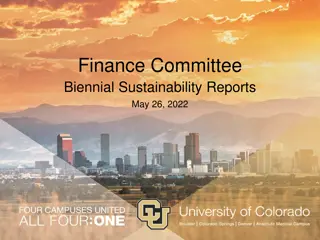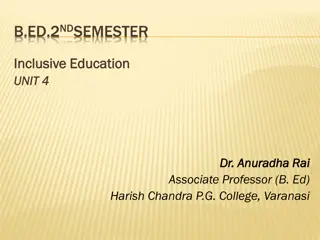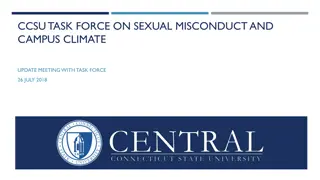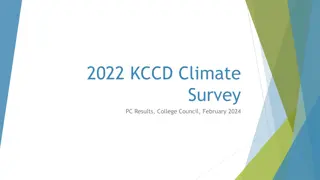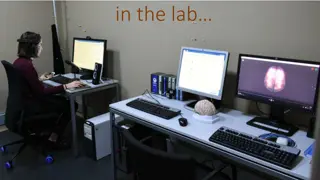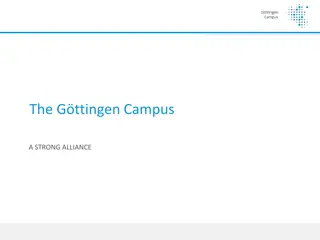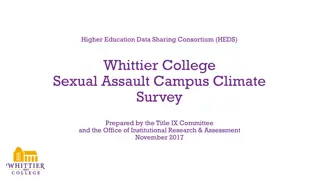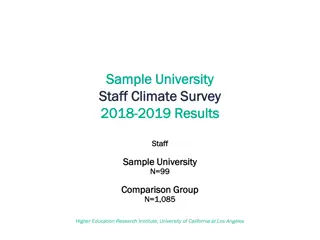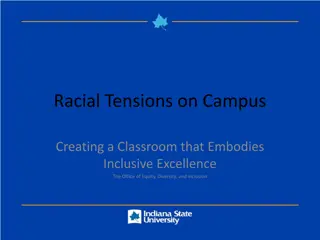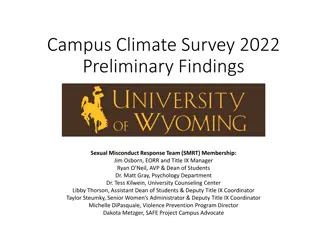UW Climate Survey: Cultivating Inclusive Campus Environment
The UW Climate Survey, rooted in the Diversity Blueprint, aims to create an inclusive, equitable, and welcoming environment for diverse individuals on UW campuses. The timeline outlines the survey process from decision-making and consultant selection to reporting and action plan development. Definitions and analyses cover key aspects of campus climate, including attitudes, behaviors, respect levels, and experiences. The survey targets four distinct populations at different campuses for comprehensive reporting.
Download Presentation

Please find below an Image/Link to download the presentation.
The content on the website is provided AS IS for your information and personal use only. It may not be sold, licensed, or shared on other websites without obtaining consent from the author.If you encounter any issues during the download, it is possible that the publisher has removed the file from their server.
You are allowed to download the files provided on this website for personal or commercial use, subject to the condition that they are used lawfully. All files are the property of their respective owners.
The content on the website is provided AS IS for your information and personal use only. It may not be sold, licensed, or shared on other websites without obtaining consent from the author.
E N D
Presentation Transcript
Chapter 24 THE COLLECTION AND USE OF THIRD-PARTY RECORDS 1
What is Important to Remember? The text, especially in the notes, gets deeply into the weeds with hypotheticals and special cases without well developed law. This is meant to help you think about how to analyze these problems. You do not need to memorize any of the detailed note materials. For example, you should know the basics of NSLs and the constitutional problem they posed before being amended. You should know the basic difference between Section 215 collection and 702 collection, but you do not need to know the nuanced discussion of 215 or its history.
National Security Letters A scary administrative subpoena for national security investigations. 3
18 U.S.C. 2709 National Security Letters Duty to provide. A wire or electronic communication service provider shall comply with a request for subscriber information and toll billing records information, or electronic communication transactional records in its custody or possession made by the Director of the Federal Bureau of Investigation under subsection (b) of this section. (not the content of email, just metadata and business records.) 4
Who issues a NSL? (b) Required certification. The Director of the Federal Bureau of Investigation, or his designee in a position not lower than Deputy Assistant Director at Bureau headquarters or a Special Agent in Charge in a Bureau field office designate d by the Director, may 6
What does the Director have to Certify? (1) if the Director (or his designee) certifies in writing to the wire or electronic communication service provider to which the request is made that the name, address, length of service, and toll billing records sought are relevant to an authorized investigation to protect against international terrorism or clandestine intelligence activities, [Since this is metadata, it is classic third-party data without an expectation of privacy. Thus, the warrant clause is not triggered.] 7
Limitation of the purpose of an investigation provided that such an investigation of a United States person is not conducted solely on the basis of activities protected by the first amendment to the Constitution of the United States. . . . 8
Limitations on disclosure by the recipient [not government minimization] (c) Prohibition of certain disclosure. No wire or electronic communication service provider, or officer, employee, or agent thereof, shall disclose to any person that the Federal Bureau of Investigation has sought or obtained access to information or records under this section. . . . Does this apply to the entity's lawyer? Does that raise constitutional issues? 9
Doe v. Ashcroft (Doe I), 334 F. Supp. 2d 471 (2004) 10
Facts Doe is an ISP, one of whose clients is the NYC ACLU. Which might have been a target Doe still cannot say what the NSL asked for. Doe receives an NSL asking for the statutorily defined account information. Doe was to provide the requested records directly to an agent and not email them. Doe did not comply and violated the NSL by calling the ACLU.
Alternative to NSL: Administrative Subpoenas (no secrecy) Remember these do not require court approval. The agency can petition the court in limited circumstances for a temporary gag order. Courts will enforce the subpoena as long as: (1) the agency s investigation is being conducted pursuant to a legitimate purpose, (2) the inquiry is relevant to that purpose, (3) the information is not already within the agency s possession, and (4) the proper procedures have been followed. You can either go to court when you get the subpoena, or you can wait for the agency to go to court to enforce the subpoena. Before you contest the subpoena, be sure you do not have a duty to comply because you are in a regulated industry. 13
Alternative to NSL: Criminal Subpoenas Does a judge have to make probable cause determinations before a criminal subpoena is issued? How do you get judicial review? Why are the standards different from search warrants? How is the execution of the orders different? Why does this allow a different path for judicial review? As with administrative subpoenas, any secrecy order requires petitioning the court and will be temporary. 14
National Security Letters As Intimidation [The court found] that hundreds of NSL requests were made during that period (2001 through January 2003). Because 2709 has been available to the FBI since 1986 (and its financial records counterpart in RFPA since 1978), the Court concludes that there must have been hundreds more NSLs issued in that long time span. The evidence suggests that, until now, none of those NSLs was ever challenged in any court. . . . 15
What is the implication of no one other than Doe challenging an NSL? . . . The Court thus concludes that in practice NSLs are essentially unreviewable because, as explained, given the language and tone of the statute as carried into the NSL by the FBI, the recipient would consider himself, in virtually every case, obliged to comply, with no other option but to immediately obey and stay quiet. 16
Is 2709(c) a Prior Restraint? First, axiomatically the categorical non-disclosure mandate embodied in 2709(c) functions as prior restraint because of the straightforward observation that it prohibits speech before the speech occurs. As the Supreme Court articulated the threshold inquiry: The relevant question is whether the challenged regulation authorizes suppression of speech in advance of its expression. There is a long discussion of the 1stAmendment restrictions on prior restraint of speech. You are not responsible for this material. We will revisit prior restraint in later chapters. 17
Fixing 2709(c) The court found that it was unconstitutional to imply that a recipient of a national security letter cannot contact his or her lawyer. These provisions were changed in a revision of the Patriot Act, mooting this case. It is constitutional to prevent a recipient from talking to the public and reporters, so Doe is still very limited in what he can say about this case. 18
The Current Status of National Security Letters Post 9/11 amendments have clarified national security letter law and provided substantial authority for national security letters. See chart on p. 725 in the text. 19
Carpenter There is a brief section of Carpenter that reviews our previous discussion that Carpenter does not intend to change general third-party doctrine. It does not change the availability of TP records with a subpoena. Carpenter only affects records in which a person has a reasonable expectation of privacy. Remember, the key change in Carpenter is the Court deciding that some aggregate of cell tower metadata reaches the level of the invasion of an expected privacy right.
Bulk Data Collection This section deals with bulk data collected under Section 215 of FISA. Chapter 22 dealt with bulk data collected with a FISA warrant under 702. 21
ACLU v. Clapper, 785 F.3d 787 (2015) This case does not reach the Constitutional issue of whether bulk collection is fundamentally different from the usual 3rd party exception from the warrant requirement. It focuses on the use of a FISA warrant for bulk collection. (215 is amended in 2015, likely because of the Snowden s revelations. This case deals with the old version.) 22
What is Bulk Data in ACLU v. Clapper? Unlike what is gleaned from the more traditional investigative practice of wiretapping, telephone metadata do not include the voice content of telephone conversations. Rather, they include details about telephone calls, including, for example, the length of a call, the phone number from which the call was made, and the phone number called. Metadata can also reveal the user or device making or receiving a call through unique identity numbers associated with the equipment (although the government maintains that the information collected does not include information about the identities or names of individuals), and provide information about the routing of a call through the telephone network, which can sometimes (although not always) convey information about a caller s general location. 23
Section 215 215 allows the Director of the FBI or his designee to make an application for an order requiring the production of any tangible things (including books, records, papers, documents, and other items) for an investigation to obtain foreign intelligence information not concerning a United States person or to protect against international terrorism or clandestine intelligence activities. 24
The Order The order was classified and remained secret until leaked by Edward Snowden. The order directed Verizon Business Network Services, Inc. ( Verizon ), a telephone company, to produce to the NSA on an ongoing daily basis all call detail records or telephony metadata created by Verizon for communications (I) between the United States and abroad; or (ii) wholly within the United States, including local telephone calls. 25
The Database The NSA put all of the data into a government (NSA) database for later searching. The data could be searched with specific identifiers, called seeds. A seed, followed through several hops, could generate thousands of call detail records (CDRs). (Next slide) 26
Call Event Hop Scenario and Method of Counting 27
The Legal Problem 50 U.S.C. 1861(a)(1). In its current form, the provision requires such an application to include a statement of facts showing that there are reasonable grounds to believe that the tangible things sought are relevant to an authorized investigation (other than a threat assessment) conducted in accordance with subsection (a)(2) of this section to obtain foreign intelligence information not concerning a United States person or to protect against international terrorism or clandestine intelligence activities 28
What are the Criteria for a Threat Assessment? After all, when conducting a threat assessment, FBI agents must have both a reason to conduct the inquiry and an articulable connection between the particular inquiry being made and the information being sought. The telephone metadata program, by contrast, seeks to compile data in advance of the need to conduct any inquiry (or even to examine the data), and is based on no evidence of any current connection between the data being sought and any existing inquiry. 29
Rejecting the Order The court found that Section 215 required some link to a defined investigation before the FISC could order collection. Since the nature of bulk collection is to build a database for future searches, it cannot satisfy this requirement. Interestingly, without Snowden s leak, this program might still be going on. Another example of the NSA assumption that the search is querying the data, not collecting the data. 30
Tweaks Obama limited searches to three hops, but this didn t solve the 215 question about relevance. Congress amended the law to require that the phone companies hold the data, not the agency. This solves the collection problem. Agencies then get a warrant to do targeted searches in the company data. 31
Current Status of the Program The carriers holding the data has not worked out well. The program has been suspended because of problems with carrier data. Investigations of the program show that it has turned out very few leads. Carpenter puts its constitutional basis in question. Whatsapp and its ilk make the program irrelevant. Section 215 sunsetted in 2020 and has not been renewed. 32
Access to Certain Business Records for Foreign Intelligence and International Terrorism Investigations 50 U.S.C. 1861 (2018) A limited version of 215 This requires a more specific showing and provides more limits on collection. The next question is whether Section 215 will be renewed.
Data Mining All of those records that are still considered classic third-party records and thus are available without a warrant. Financial records, including credit card records Store checkout records, including pharmacy checkout record. Google searches Social media data What else can you think of? What questions are posed by government access and searching of these records?
THE COLLECTION AND USE OF THIRD-PARTY RECORDS: SUMMARY OF BASIC PRINCIPLES The government needs affirmative authority for the collection of third-party records. In the national security field, such authority is provided by statutes approving the use of national security letters (NSLs) or Section 502(a) orders to collect particular kinds of third- party records and FISA authority for pen registers and trap and trace devices, in addition to traditional authorities in criminal law. Most of these authorities for the collection of third-party records require that the collection be relevant to or for an authorized investigation to collect foreign intelligence or that it concern international terrorism a subpoena-like standard that is more relaxed than traditional probable cause or even FISA probable cause. Under authorities that have since expired, the government conducted not only targeted collection of business records, but also bulk collection of both Internet and telephony metadata after 9/11.
Courts disagreed about whether the bulk collection of telephony metadata was authorized by then-existing statutory authority or consistent with the Fourth Amendment. For example, the FISC invoked the third-party doctrine from Smith v. Maryland to reject a Fourth Amendment challenge to bulk collection of telephony metadata. But the Ninth Circuit was sympathetic to a similar challenge on the grounds that telephony metadata are arguably distinguishable both in quantity and quality from the telephone numbers at issue in Smith. (It ultimately ruled that the bulk collection at issue was not authorized by then-existing statutory authority, as had the Second Circuit in a separate case.) The collection and retention of bulk data by the government raises the question whether a person has a constitutionally protected privacy interest in the government s aggregation of data that has been lawfully collected under the third-party doctrine. The substantial risk of false positives in the government s use of such data also raises the question whether it should be subjected to tighter statutory regulation. Intelligence community lawyers have disagreed about whether the Supreme Court s reasoning in Carpenter applies to the government s purchase of third- party data from commercial database vendors, in light of allegedly reduced expectations of privacy in such data.
